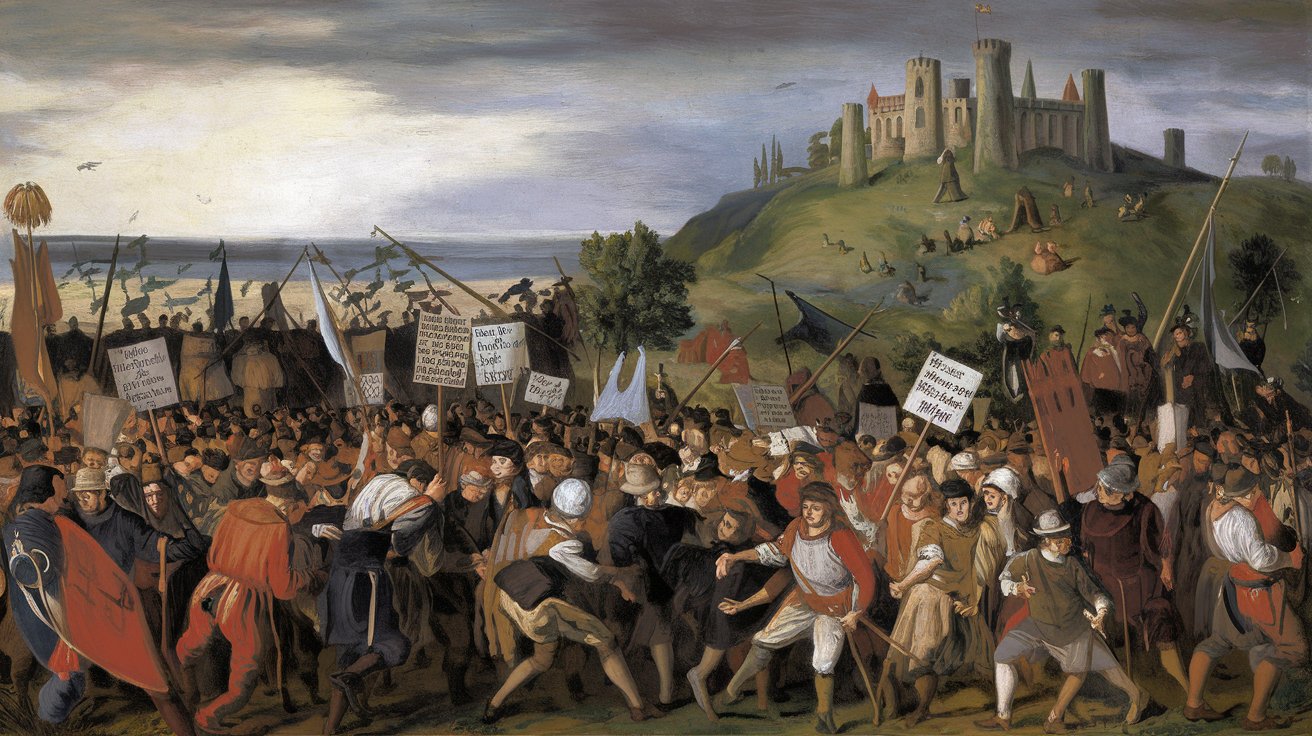
What sparked the Peasant Revolt in Flanders between 1323 and 1328? The Peasant Revolt in Flanders was ignited by a combination of heavy taxation, economic hardship, and social inequality. Peasants, burdened by high taxes imposed by the Count of Flanders, found themselves struggling to make ends meet. Additionally, the region faced economic decline due to poor harvests and trade disruptions. The nobility's lavish lifestyle and the church's demands further fueled resentment among the lower classes. This bubbling discontent eventually erupted into a full-scale rebellion, as peasants banded together to challenge their oppressors. The revolt highlighted the growing tension between the ruling elite and the common folk, setting the stage for significant social and political changes in medieval Flanders.
Key Takeaways:
- The Peasant Revolt in Flanders from 1323 to 1328 was a major uprising against unfair treatment of peasants, leading to battles, loss of life, and a lasting impact on social divisions.
- The revolt, led by figures like Nicolaas Zannekin and Willem de Deken, inspired future uprisings and is remembered as an early example of the fight for social justice in medieval Europe.
Background of the Peasant Revolt in Flanders
The Peasant Revolt in Flanders from 1323 to 1328 was a significant uprising against feudal oppression. It was fueled by economic hardship, high taxes, and social injustice. Let's explore some fascinating facts about this historical event.
-
The revolt began in the coastal regions of Flanders, particularly in the towns of Bruges and Ypres.
-
Economic hardship was a major cause, as peasants faced high taxes and poor harvests.
-
The revolt was also fueled by resentment towards the nobility and their luxurious lifestyles.
-
Peasants were particularly angry about the "taille," a direct tax imposed by the Count of Flanders.
-
The revolt quickly spread to other parts of Flanders, including Ghent and Courtrai.
Key Figures and Leaders
Several key figures played crucial roles in the Peasant Revolt. These leaders rallied the peasants and directed their anger towards the ruling class.
-
Nicolaas Zannekin emerged as one of the main leaders of the revolt.
-
Zannekin was a wealthy farmer from Lampernisse who became a symbol of resistance.
-
Another notable leader was Willem de Deken, who led the revolt in the town of Ypres.
-
The leaders organized the peasants into a formidable fighting force.
-
They used guerrilla tactics to harass and disrupt the noble forces.
Major Battles and Events
The Peasant Revolt saw several significant battles and events that shaped its course. These confrontations highlighted the determination and resilience of the peasants.
-
The Battle of Cassel in 1328 was a decisive conflict during the revolt.
-
At Cassel, the peasant forces faced the army of King Philip VI of France.
-
Despite their bravery, the peasants were ultimately defeated at Cassel.
-
The defeat at Cassel marked the beginning of the end for the revolt.
-
Another important event was the siege of Bruges, where peasants captured the city for a brief period.
Impact and Consequences
The Peasant Revolt had lasting impacts on Flanders and its social structure. The consequences of the uprising were felt for years to come.
-
The revolt led to significant loss of life, with thousands of peasants killed.
-
Many leaders of the revolt, including Nicolaas Zannekin, were executed.
-
The nobility regained control, but the revolt left a lasting fear of peasant uprisings.
-
The revolt highlighted the deep social and economic divisions in Flanders.
-
It also led to some minor reforms, as the nobility sought to prevent future uprisings.
Legacy of the Revolt
The legacy of the Peasant Revolt in Flanders is still remembered today. It serves as a reminder of the power of collective action and the fight for justice.
-
The revolt is often seen as an early example of class struggle in Europe.
-
It inspired future peasant uprisings in other parts of Europe.
-
The events of the revolt have been depicted in various historical texts and artworks.
-
The revolt is commemorated in Flanders through local traditions and festivals.
-
It remains a significant chapter in the history of medieval Europe, illustrating the enduring struggle for social justice.
The Lasting Impact of the Peasant Revolt
The Peasant Revolt in Flanders from 1323 to 1328 left a significant mark on history. This uprising wasn't just a fleeting moment of unrest; it highlighted the deep-seated grievances of the lower classes against feudal oppression. The revolt showcased the power of collective action, even among those with limited resources. Though the rebellion was eventually crushed, it forced the ruling elite to reconsider their policies and treatment of peasants. The revolt also paved the way for future uprisings, inspiring other oppressed groups to stand up for their rights. Understanding this revolt helps us grasp the complexities of medieval society and the ongoing struggle for social justice. The Peasant Revolt in Flanders serves as a powerful reminder that even the most marginalized voices can spark significant change.
Frequently Asked Questions
Was this page helpful?
Our commitment to delivering trustworthy and engaging content is at the heart of what we do. Each fact on our site is contributed by real users like you, bringing a wealth of diverse insights and information. To ensure the highest standards of accuracy and reliability, our dedicated editors meticulously review each submission. This process guarantees that the facts we share are not only fascinating but also credible. Trust in our commitment to quality and authenticity as you explore and learn with us.
